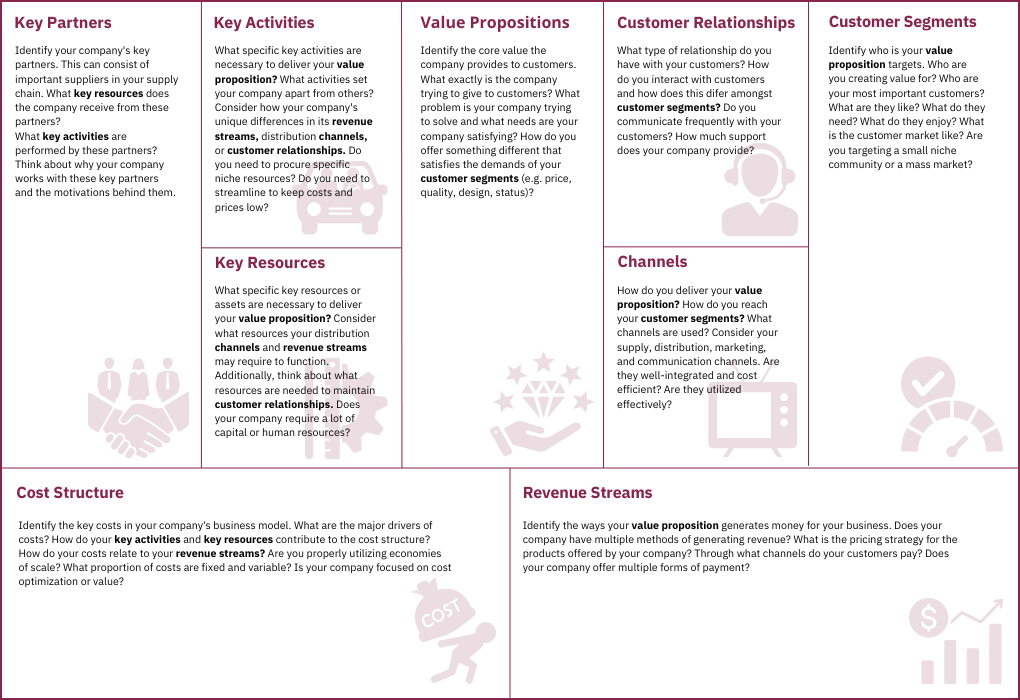A business model canvas is a strategic management tool that provides a detailed summary of a company’s key components. Business Model Canvas allows companies to address specific risks while also learning more about competitors, expenses, customer segments, or a market niche. It’s a flexible, collaborative tool for communicating and analysing business strategy.

The following are the key elements of a business model canvas:
- Customer Segments
- Value Propositions
- Channels
- Customer Relationships
- Revenue Streams
- Key Resources
- Key Activities
- Key Partnerships
- Revenue Streams
- Cost Structure
How does market research help in developing business model canvas?
Market research plays a crucial role in drafting the development and utilization of the Business Model Canvas. Through market research, companies can gain valuable insights that inform the various components of the canvas, enhancing their understanding of the business model and strategic decision-making.
Successful businesses don’t succeed solely because of the products or services they offer, but because of the deep insights they have about their target market. Market research provides the critical information companies need to understand customer needs, preferences, and behaviours, as well as the competitive landscape and industry dynamics.
Key partnership:
Key partners are the external companies or suppliers that will help carry out key activities of a company. These partnerships are forged in order to reduce risks and acquire resources.
Types of partnerships are:
- Strategic alliance: partnership between non-competitors
- Coopetition: strategic partnership between partners
- Joint ventures: partners developing a new business
- Buyer-supplier relationships: ensure reliable supplies
One of the key factors to consider is complementary behaviour – companies should seek partners that have skills, resources, values, and customer bases that complement their own business. Beyond complementarity, market research can help evaluate additional important factors, such as the potential partner’s reputation, financial stability, market share, growth potential, and innovation capabilities. These insights are essential in determining the overall fit and compatibility of a partnership.
To gather this information, market research can leverage various sources and methods, including:
- Online databases and trade journals to research industry players
- Industry associations and referrals to identify potential partners
- Social media and surveys to gauge reputation and customer sentiment
- Interviews and focus groups to understand the partner’s culture, vision, and mission
Once a list of potential partners is obtained, a thorough evaluation and comparison can be performed. This includes analysing their strengths, weaknesses, opportunities, and threats (SWOT) to assess how they align with the business’s objectives and criteria.
Key activities:
Key activities should focus on fulfilling a company’s value proposition, reaching customer segments and maintaining customer relationships, and generating revenue.
Market research can help businesses identify the critical tasks needed to run efficiently and deliver on their value proposition. This includes understanding the specific duties and procedures that must be followed in order for the business to succeed. It can also be used to analyse the competitive environment and identify areas where a company can differentiate itself through core competencies. This can help identify areas for improvement and optimize processes to achieve better results. It can also help guide strategic decisions about how to position the company in the market.
Value Proposition:
Value proposition represents your unique solution (product or service) for a problem faced by a customer segment, or that creates value for the customer segment. To stand out in the market, value proposition must be distinct from competitors. For new products, innovation and disruption are key, while existing offerings should showcase novel features and attributes that set them apart. Value propositions can be quantitatively driven by factors like price and speed, or qualitatively by aspects such as customer experience and design.
By conducting market research competitors’ offerings, pricing strategies, and market positioning can be analysed and businesses can identify opportunities for differentiation and conduct comparative analyses to gauge their competitive edge. Through surveys, interviews, and focus groups, market research delves deep into the needs, desires, and pain points of target customer segments. Techniques like price sensitivity studies and tools such as Van Westendorp’s Price Sensitivity Meter help determine optimal pricing strategies. Continuous market research enables businesses to stay attuned to evolving customer preferences and market trends, allowing for ongoing refinement and enhancement of the value proposition to ensure sustained relevance and competitiveness in the dynamic business landscape.
Customer relations:
The diverse customer bases of various products or services requires tailored approaches for effective engagement. For instance, where a cup of black coffee priced at 250 rupees may be perceived differently in urban centers compared to small towns due to varying demographics and preferences. Each location caters to distinct customer segments, demanding unique strategies for connection and establishment.
By conducting thorough research on different customer segments, companies can craft personalized customer relations approaches tailored to specific groups. This enables more targeted communication strategies and fosters deeper, more meaningful interactions. Moreover, market research aids in analysing customer satisfaction levels, pinpointing areas for improvement in customer relations. By understanding customer feedback and sentiments, businesses can change their relationship-building efforts and elevate customer experiences.
Furthermore, market research guides companies in identifying the most effective communication channels to reach and engage with their target customers this ensures that customer relations initiatives are channelled through optimal platforms for maximum impact. Additionally, market research unveils the drivers of customer loyalty and retention, shedding light on what keeps customers engaged with a company.
Channels:
Channels are crucial in raising awareness about products or services and delivering value propositions. They provide avenues for customers to make purchases and access post-purchase support, shaping the overall customer experience. There exist three different channels of distribution:
- In direct distribution channels, companies engage directly with customers, often selling products through their own websites or retail outlets. For instance, Amazon manufactures and sells the Kindle through its e-commerce platform.
- Indirect distribution channels involve intermediaries like retailers, distributors, and representatives, offering after-sales services and expanding brand reach in a cost-effective manner.
- Hybrid distribution channels blend elements of both direct and indirect models, allowing companies to leverage multiple sales approaches. Apple is an example of this with its direct sales and third-party retail options.
Market research is essential for determining the most suitable distribution channel for a product based on its nature and the company’s goals. Choosing the wrong channel may hamper sales and product growth.
Customer segment:
Companies can strengthen their value proposition and customer relationships by customizing solutions to meet the unique needs of each customer segment. Businesses can better meet the diverse needs of their clientele by segmenting their consumer base based on shared characteristics such as location, gender, age, habits, and interests.
To ensure the validity and accuracy of the identified customer segments, market research is required. Businesses can be informed that they are successfully targeting the right customer segments by validating their assumptions through performance tracking and continuous feedback analysis, this allows businesses to improve resource allocation, optimize their strategies, and provide customized solutions that appeal to their target market.
Cost structure:
The Cost Structure describes all costs associated with running a business model. Costs can be calculated after identifying Key Resources, Key Activities, and Key Partnerships.
Businesses can be cost-driven (focused on minimizing costs whenever possible) or value-driven (focused on providing maximum value to the customer).
Market research helps businesses make informed decisions concerning their cost structure by identifying key cost drivers, evaluating pricing strategies, assessing economies of scale, determining fixed vs. variable costs, identifying cost-cutting opportunities, and aligning costs with the value proposition. To develop the best possible pricing strategy that balances cost containment and revenue generation, it is necessary to understand pricing sensitivity, competitive pricing, and customer willingness to pay. Furthermore, market research on consumer behaviour and demand variations can help businesses differentiate between fixed and variable costs, allowing for better budgeting and cost control.
Revenue streams:
Revenue streams are the sources of income that a company generates by providing a product or service to its customers.
One of the following revenue models could include a revenue stream:
- Transaction-based revenue is generated by customers who make a single purchase.
- Recurring revenue is generated from recurring payments for post-sale or ongoing services.
Market research allows businesses analyse revenue streams from customers, events, advertising, and marketing, and determine appropriate pricing. A company may generate several royalties from its products or services, yet these revenues may not be realized due to a lack of awareness. Here is a sample business model canvas

Businesses may face significant disadvantage if they rely solely on speculation or insufficient market data. A lack of comprehensive market research can lead to inaccurate pricing, resulting in inadequate ROR or lost revenue opportunities, which can have a negative impact on the overall financial viability of the business model.
As a result, market research is a critical tool for ensuring that businesses develop a stable and long-term revenue structure that is tailored to the demands and characteristics of their target market.
Talk to our expert consultants to develop your business model canvas.





 Market Research
Market Research Consumer Research
Consumer Research Industry Research
Industry Research Market Entry Strategy
Market Entry Strategy Feasibility Studies
Feasibility Studies Product Research
Product Research Automobile & Mobility
Automobile & Mobility Banking and Finance
Banking and Finance Consumer Products & FMCG
Consumer Products & FMCG Ecommerce & Retail
Ecommerce & Retail Industry & Manufacturing
Industry & Manufacturing Government & Public Sector
Government & Public Sector Industry Associations
Industry Associations Technology & Software
Technology & Software Venture Capital & PE
Venture Capital & PE Consulting & Advisory
Consulting & Advisory India Entry Market Research
India Entry Market Research Innovation Consulting
Innovation Consulting KX Market Radar
KX Market Radar Business Model Development
Business Model Development Gen Z Navigator
Gen Z Navigator